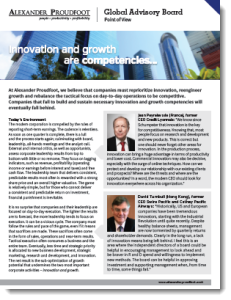
Corporations are bound by the rules of short-term earnings. It is a vicious cycle that repeats itself every quarter and consumes a significant amount of an executive's time. During this short window of time, the goal is to produce consistent and predictable results that will, in turn, deliver a strong share price and a higher valuation. In order to keep up, priorities typically shift to the day-to-day execution of operations
Facing adversity
Foreign markets that produce lower cost solutions and displace traditional product lines are a real threat to our economy. Eroding profit margins and accelerated product life cycles are preventing the potential for growth. For example, more than 50% leading companies within the Fortune 1000 had less than 2% compound annual growth rates between 2009 and 2013 despite reasonable net income returns. Trends like this are what draw companies into the downward spiral of tactical execution as a way to sustain net incomes. SG&A reductions in strategy, new business development, marketing and product development are typical knee-jerk reactions that only serve to mask the underlying issues.
Rising up to the challenge
The vast majority of senior executives recognize the importance of innovation and growth as they relate to success. The problem is, most of them struggle with the mechanics and deployment of such initiatives. Companies should annually hit more than 20% sustainable growth targets to stay ahead of the competition and related business threats. The following core principals of innovation and growth are needed to make this happen:
- Appoint a revenue growth leader
- Dedicate staff to key focus areas
- Create a strong SWOT analysis
- Find parallels between markets and products
- Develop a growth hypothesis
- Permit exploration, as well as trial and error
- Encourage customer input and feedback
- Govern relentlessly (the stage gate)
- Celebrate success
- Instill a culture of innovation
- Recognize heroes and heroines
- Develop a rigorous review process
- Expect and reward results
